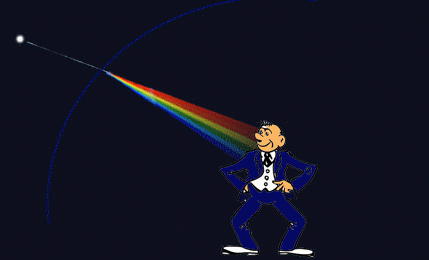 |
| Screenshot from the free planetarium, Stellarium (www.stellarium.org) |
If you've watched the night sky much, you've probably noticed how stars seem to twinkle, a phenomenon known as "scintillation". More careful observation may have revealed that the scintillation is more pronounced in stars near the horizon, and that the planets, while appearing star-like, generally don't twinkle even as the stars around them do!
In my recent post regarding the winter hexagon I described how to locate the bright blue-white star Sirius by tracing the line of stars of Orion's belt down and to the left. Sirius is the brightest star in Earth's nighttime sky, at least in part because at 8.6 light years distant it is also one of the nearest stars. For observers in northern latitudes, Sirius arcs across the southern winter sky, rising south of east a few minutes earlier each night, and setting south of west about 9 and a half hours later. By late January Sirius is high in the southern sky by 8 PM (see the image above), and on a clear cold night it puts on a dazzling show, especially if you let your eyes adjust to the dark for a while. The scintillation will be obvious, and if you look closely you'll see that the color of the star changes too - flashing rapidly from red to green to blue and back again. Here's the explanation:
The star itself neither twinkles nor changes color - those visual effects are the result of the passage of the starlight through Earth's atmosphere on the way to your eyes.
Stars, no matter how large they are, are so far away that even with a large earthbound telescope they cannot be resolved into anything more than a single point of light - we can't observe their surfaces or even resolve them into disks. When the single narrow beam of light from a star enters Earth's undulating atmosphere, it is bent, or refracted, from its perfectly straight path - first directly into your eyes (making it appear bright) and in the next instant away from your eyes (dimming it) - essentially making it twinkle.
The bright white light coming from Sirius is really a combination of all the colors of the rainbow, and atmospheric refraction can split that light into its rainbow components in the same way a prism does. The scintillation then directs and redirects the various colors to your eyes:
 |
| The scintillation and refraction of Sirius' starlight cause it to twinkle in various colors |
2 comments:
I noticed Sirius in the night sky a few days ago and didn't know what it was - or why it appeared to change from Red to Blue to Green. Today I found out it was called Sirius (I guess that at 45 years old, and with a general interest in the Universe, I should have already known the name of the brightest star in the sky). Then I found your excellent post which clearly explained why it appeared to twinkle and change colors. THANK YOU! Andrew, Houston TX USA.
I saw a bright star in the night sky a few days ago and wondered what it was and why it appeared to change from Red to Blue to Green. Today I used Stellarium to figure out that it was called Sirius. I guess that, as a 45 year old with a mild interest in the Universe, I should already have know the name of the brightest star in the sky!
Then I found your excellent explanation of why Sirius appears to twinkle and change color. THANK YOU! Andrew, Houston TX
Post a Comment